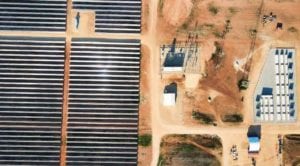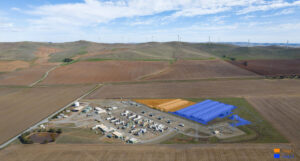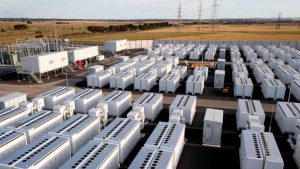French based renewable energy developer Neoen says it will seek “liquidated damages” for the delays to its ground breaking Bulgana wind and battery storage project in Victoria, in a move that highlights the perils of the renewable energy business in Australia as a result of connection delays.
The Bulgana Green Energy Hub – which comprises 194 MW of wind capacity and a 20MW/34MWh Tesla big battery – is one of a number of major large scale wind and solar and storage projects caught up by the issues in north west Victoria and south west NSW, which has seen five big solar farms have their output cut in half, and half a dozen complete or near complete projects told of length delays in commissioning to the grid.
The delays have been blamed on system strength issues in a weak part of the grid and a bottleneck of new renewable projects, but the issue has frustrated the Victoria government so much it is now taking unilateral action that it hopes will allow it to circumvent National Electricity Rules which it blames for causing many of the problems.
Neoen CEO Xavier Barbaro told analysts in a conference call overnight that he expected Bulgana to be full commissioned by the end of 2020. It had been expected to be commissioned in October last year, after all 56 turbines were installed in August.
“We have been facing some delays,” Barbaro said. “But we have a full turn-key contract with (EPC contractor) Siemens Gamesa and the delays will be offset by liquidated damages.”
The seeking of liquidated damages is not unusual in the industry, and in standard under most contracts. Indeed, in 2018 Neoen evoked liquidated damages for smaller delays at some of its NSW solar farms – Dubbo, Griffiths and Parkes – from the contractor Bouygues.
However, the issue of liquidated damages, and its impact on contractors, has grown to such an extent that it has caused a massive shake-up in the Australian contracting industry, and put investment under threat.
The Neoen claim for Bulgana could run into the tens of millions, and if repeated in other delayed projects in Victoria and NSW – as it surely will be – could end up being a disaster for parts of the industry. Already, there are rumours of projects struggling with potential debt calls, or having to declare force majeure – and the ranks of contractors has been greatly diminished in the last year because of the connection issues.
RCR Tomlinson collapsed in late 2018 under the weight of damages claims and cost over-runs, and last week Downer, one of the biggest contractors in the renewables market – said it would exit the solar market because the connection risks were intolerable. Others such as Decmil have done the same, and other contractors have also pulled back from the market.
There are now growing disputes between developers and contractors over who should be holding the hot potato of connection risk.
Windlab and its contractor at the wind, solar and battery storage project at Kennedy in north Queensland are heading for the courts because of lengthy delays to that project, although they have agreed a temporary “truce” to try and resolve the issues after a tribunal suggested that Windlab, the developer, should wear the costs of delays.
The connection risk – blamed also on the lack of infrastructure investment and the slow pace of rule changes, and some much criticised changes rushed through in the knee jerk reaction to the South Australia blackout – is one of a number of factors blamed for the sharp slump in investment in new wind and solar projects over the last six months.
Victoria energy minister Lily D’Ambrosio told RenewEconomy’s Energy Insiders podcast this week that one major investor had told her that it was looking to quit Australia because of the grid delays and other issues. One investor, John Laing, has already announced it’s putting all new projects on hold.
The liquidated damages from the delays at Bulgana could be significant. The project is expected to produce around 740,000 MWh a year, which at an average price of around $55/MWh would amount to around $40 million a year of lost revenue.
Búlgana has a 15 year “support agreement” with the Victoria government, and a 10 year off take agreement to supply a new vegetable glasshouse from Nectar Farms, but the exact details of those contracts are not public.
“Some delays can be caused by grid connection issues,” Barbaro said. “It does not mean we are not entitled to liquidated damages and penalties. In the end, when we have a full turn-key contract … it means that it is their responsibility to deliver a wind farm, or a solar farm, or a storage unit in due time.
“Whatever the reason there can be for the delay, it falls on their responsibility. There can be some exceptions, maybe Force Majeure in some instances, but this is not the example here.”
Barbaro, however, said that Neoen was not thinking of quitting Australia development opportunities, in fact it expected those opportunities to increase, particularly after the recent bushfires which Barbaro said could accelerate the energy transition in Australia.
He conceded that some of the company’s wind farms had suffered small losses in output due to the impact of smoke, which according to Solar Analytics has reduced output from rooftop solar panels by up to 45 per cent on some occasions.
“We are well placed to do more and more in australia. It’s not the end of our development in australia, it’s probably just the beginning.” Neoen’s project pipeline include the massive South Goyder and Crystal Brook renewable and storage projects in South Australia, and the Kaban renewable and storage projects in Queensland, along with the Culcairn project.
Neoen is also expanding the original Tesla big battery at Hornsdale, adding another 50MW/65MWh of capacity to allow it to become the first big battery in Australia able to provide instant inertia responses to the grid.
Hornsdale has already shaken up the market in Australia, taking a significant slice of the frequent and ancillary services market and puncturing the effective cartel run previously by the state’s big gas generators. Another four big batteries have since been connected to the grid, including Lake Bonney, Dalrymple North, Gannawarra and Ballarat.
The Bulgana battery will be unique in that it will operate “behind the meter”, with its prime purpose being to “smooth” the output of the wind farm, and to guarantee supply to the Nectar Farms glasshouse. Because of that, its performance and earnings will not be visibly separate from the wind farm that surrounds it.
See also: Tesla big battery at Hornsdale gets big jump in revenues, more to come










